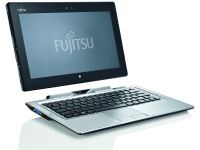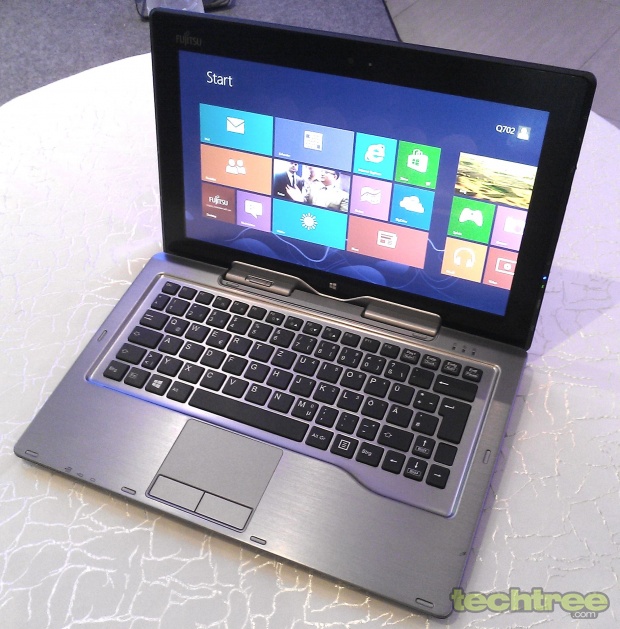-
Jayesh Limaye
28th Feb 2013
It's not been very long since Windows 8 was launched, but touchscreen laptops have already started appearing. The touch interface is something you'd typically associate with a tablet. Fujitsu's STYLISTIC Q702 tablet is a hybrid of sorts: It can snugly dock into a keyboard accessory and transform into a laptop. We had the chance to spend a few minutes with the Q702; here's what we found.
Design And Build
This Windows 8 Pro 64-bit device is technically a tablet because the essential computing hardware is inside the screen part; the keyboard is only an accessory. To be precise, it's more than an accessory because it houses additional ports and, more importantly, an additional battery.
The tablet part is encased in a rich magnesium alloy body for durability, while the keyboard accessory has a nice brushed-metal finish. The tablet snugly slides into the keyboard accessory and snaps firmly into position via a stolid mechanical lock. It is very easy to lock and unlock this mechanism via a spring-loaded slider switch, but it has also been designed to prevent accidental unlocking. The hinge is connected to this locking mechanism; we think Fujitsu could have looked at the aesthetics aspect here. The keyboard gets awkwardly raised (though not too much) as the lid is opened wider; see the photo in the gallery below to get an idea.
Weighing around 0.85 kg (with the docking port), the device is light and easy to carry.
The Q702 sports an 11.6" 10-point capacitive multi-touch display with HD-Ready pixel dimensions of 1366x768. The IPS panel has an anti-glare finish to make it easy to view even when there's light falling directly on it.
While a 1.8 GHz Intel Core i3 and i5 ultra low power variants with vPro are available to suit computing requirements, the system we checked out had a dual-core Core i5-3427U with HyperThreading. This, essentially, runs four process threads simultaneously, which is akin to a quad-core CPU — which makes it faster than a normal dual-core CPU at the same clock speed, but still slower than a real quad-core. 4 GB of DDR3 RAM is standard in the Q702. There are SSD options of 128 GB and 256 GB, where the latter also has full data encryption (FDE). (Our unit had the 256 GB SSD.)
This tablet is geared more towards professionals, and it has the biometric login option via a fingerprint scanner on the rear. The tablet features Intel HD 4000 integrated graphics. A 5 mp rear camera and front HD cam are built in to facilitate video conferencing. Wireless connectivity is via Wi-Fi 802.11 a/b/g/n and Bluetooth 4.0. There is also a 3G/4G SIM slot for on-the-go internet connectivity.
The tablet itself has a USB 2.0 and HDMI port on the left, in addition to a microphone and earphone socket. There are buttons for power, volume control, orientation lock, and even one to switch Wi-Fi on or off (which comes handy to save power while mobile). The right side of the tablet has a USB 3.0 port to connect faster peripheral devices, and a SDXC slot that supports cards up to 64 GB. A ventilation grille channels out hot air to keep the unit running cool.
The keyboard docking station has additional ports of its own: One USB 2.0 port each on the left and right, an Ethernet port on the left, and a D-Sub port on the right. A digital stylus, tucked in on the left, can be used with the touchscreen — to scribble notes, for example. The underside has a large flat removable battery that can be charged separately in the docking station. You can purchase additional batteries to charge and carry along for more backup. The battery in the tablet gets charged when it is docked to the station (along with the battery in the dock).
Performance
Booting takes just around 10 seconds, thanks to the SSD and the fast CPU. We had restrictions on running benchmarks, but the smooth performance, without lag of any sort, was visible. Productivity applications launched in a split-second, and overall, the system seemed more well-oiled than a typical desktop computer.
The touchscreen performance, while not as good as on the iPad, is smooth enough to make it comfortable to work with. It takes full advantage of the touch-specific features of the Windows 8 UI. Pixel dimensions of 1366x768 at 11.6" make it appear better than netbooks with pixel dimensions of 1024x600, because the pixels are more densely packed. Viewing angles are very good because of the IPS panel, and so is the colour reproduction.
The keyboard is comfortable enough, with well-spaced keys and good tactile feedback. The touchpad supports multi-touch, and is pretty responsive as well. Thankfully, there are separate mouse buttons. The keys are not backlit, though.
Audio performance seemed decent, although it was difficult to gauge the loudness in a crowded hall.
We couldn't test battery life, but we've been told that the standalone tablet can work for 4 hours without recharging — while the backup doubles to over 9.5 hours in docked mode.
The Verdict (Thus Far)
The Fujitsu STYLISTIC Q702 appears to be a promising product at first glance. A tablet that easily transforms it into a fully functional laptop is an attractive proposition. Performance is good — to the extent we could gauge in around 15 minutes — but we can't pass judgment before conducting a detailed review. Customers can configure the Fujitsu STYLISTIC Q702, choosing an Intel Core i3 or i5, and 128 GB or 256 GB SSD. The base version with a Core i3 and 128 GB SSD is available for Rs 69,000 excluding local taxes and comes with a 2-year warranty, while Fujitsu is yet to announce the price of the one we tried out today (Core i5 and 256 GB SSD).
Pros: Excellent build; Fast performance; Lightweight; Internet connectivity via SIM card.
Cons: Slightly uncomfortable hinge design; Expensive.
Hands On — Fujitsu STYLISTIC Q702 | TechTree.com
Hands On — Fujitsu STYLISTIC Q702
This Windows 8 tablet can transform into a laptop and aspires to give the best of both worlds.
News Corner
- DRIFE Begins Operations in Namma Bengaluru
- Sevenaire launches ‘NEPTUNE’ – 24W Portable Speaker with RGB LED Lights
- Inbase launches ‘Urban Q1 Pro’ TWS Earbuds with Smart Touch control in India
- Airtel announces Rs 6000 cashback on purchase of smartphones from leading brands
- 78% of Indians are saving to spend during the festive season and 72% will splurge on gadgets & electronics
- 5 Tips For Buying A TV This Festive Season
- Facebook launches its largest creator education program in India
- 5 educational tech toys for young and aspiring engineers
- Mid-range smartphones emerge as customer favourites this festive season, reveals Amazon survey
- COLORFUL Launches Onebot M24A1 AIO PC for Professionals









Reader Comments (4)